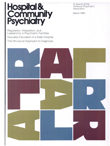Building a Network of Aftercare Services
Abstract
When a state hospital in New York began returning long-term psycbiatric patients to community living in Westchester County in 1974, the staff of the hospital, local community mental health providers, administrators of a private proprietary home for adults that received many of the patients, and local citizens worked to develop an integrated system of aftercare services. The local mental health council served as the umbrella group for the coordination of the various providers and consumers. The council's aftercare committee investigated several troubling aspects of the deinstitutionalization process including patient selection, the program and staffing of the home, transportation for residents, the physical structure of the home, and its licensing. The authors report the committee's findings and resolutions of some of the problems, and discuss some of the financial difficulties of residents in the home. While some problems remain, the authors feel that the council structure was a crucial element in facilitating a coordinated network of aftercare services.
Access content
To read the fulltext, please use one of the options below to sign in or purchase access.- Personal login
- Institutional Login
- Sign in via OpenAthens
- Register for access
-
Please login/register if you wish to pair your device and check access availability.
Not a subscriber?
PsychiatryOnline subscription options offer access to the DSM-5 library, books, journals, CME, and patient resources. This all-in-one virtual library provides psychiatrists and mental health professionals with key resources for diagnosis, treatment, research, and professional development.
Need more help? PsychiatryOnline Customer Service may be reached by emailing [email protected] or by calling 800-368-5777 (in the U.S.) or 703-907-7322 (outside the U.S.).



